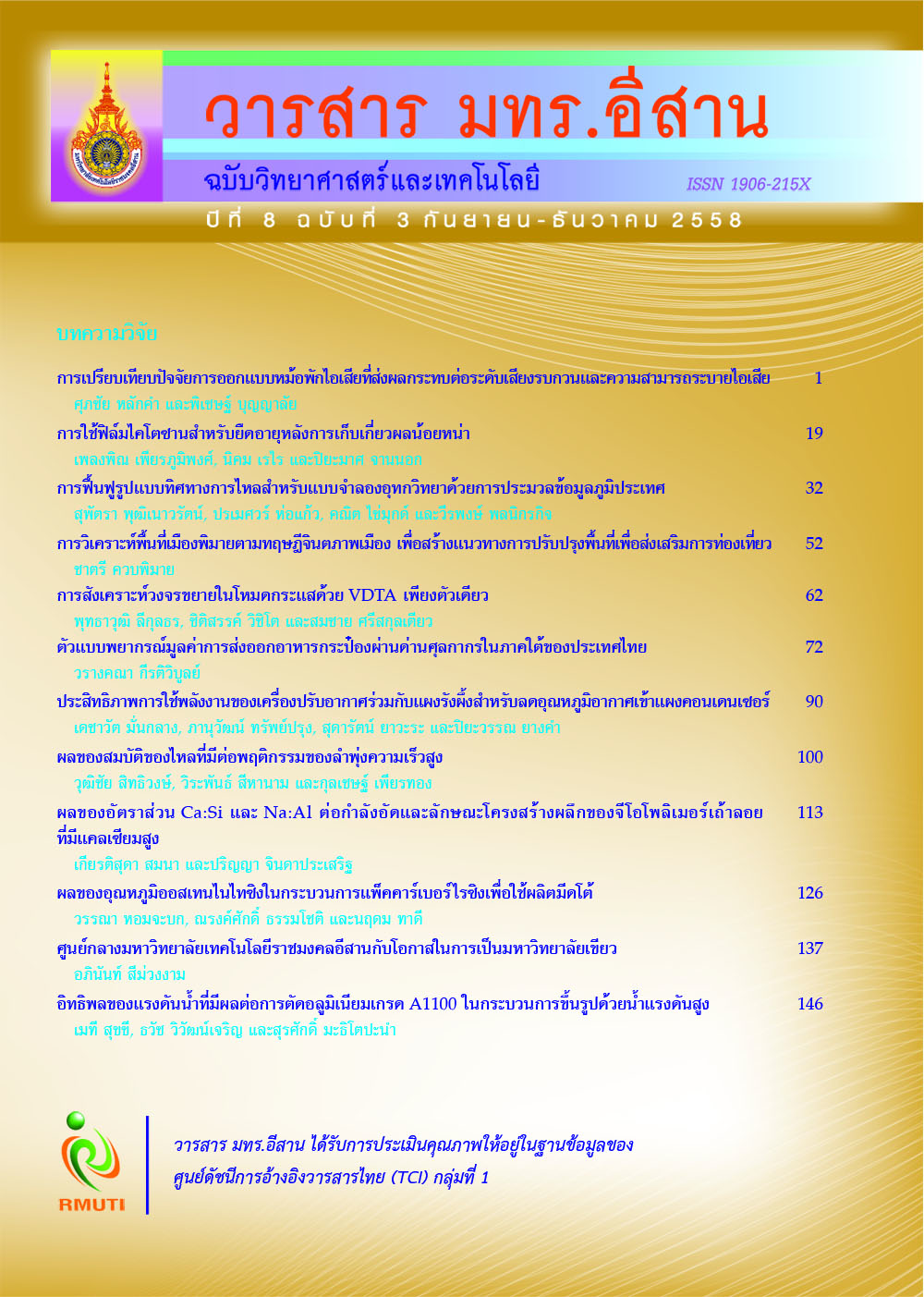การเปรียบเทียบปัจจัยการออกแบบหม้อพักไอเสียที่ส่งผลกระทบต่อระดับ เสียงรบกวนและความสามารถระบายไอเสีย A Comparison of Design Factors of Muffler Affecting on Sound Pressure Level and Exhaust Flow Capability
Main Article Content
Abstract
ปัจจุบันเสียงรบกวนจากยานพาหนะถือเป็นปัญหาสิ่งแวดล้อมหนึ่งที่หลีกเลี่ยงมิได้ ดังนั้นการออกแบบ
หม้อพักไอเสียเพื่อลดระดับเสียงรบกวนควบคู่กับการรักษาสมรรถนะของเครื่องยนต์เป็นอีกสิ่งหนึ่ง
ที่ต้องคำนึงถึงสำหรับการออกแบบ งานวิจัยนี้ได้เปรียบเทียบปัจจัยการออกแบบหม้อพักไอเสียที่มีอิทธิพล
ต่อเสียงรบกวน โดยตรวจวัดค่าความดันไอเสียที่สภาวะความเร็วรอบเครื่องยนต์ที่ 1,000 rpm ซึ่งเป็น
รอบเดินเบา และ 4,000 rpm ซึ่งเป็นรอบที่มีแรงบิดสูงสุดของรถยนต์ทดสอบ เพื่อนำไปกำหนดขอบเขต
และเงื่อนไขในการจำลองการไหลไอเสียภายในหม้อพักไอเสียทั้ง 3 แบบ ที่มีใช้อยู่ทั่วไปในปัจจุบัน
ด้วยระเบียบวิธีเชิงตัวเลขของโปรแกรมสำเร็จรูป Solid Works และศึกษาพฤติกรรมการไหลและแนวโน้ม
ในการลดเสียงรบกวนจากค่าความดันแตกต่างภายในหม้อพักไอเสีย อีกทั้งได้ขึ้นรูปหม้อพักไอเสีย
3 แบบดังกล่าว เพื่อทำการตรวจวัดระดับเสียงรบกวนตามมาตรฐาน กรมการขนส่งทางบก
ผลการทดสอบสะท้อนให้เห็นว่า ปัจจัยหลักในการออกแบบคือทิศทางและระยะทางการไหล
ของท่อไอเสียที่มีอิทธิพลต่อเสียงรบกวน โดยการเปลี่ยนแปลงทิศทางการไหลและการเพิ่มระยะทางการไหล
จะช่วยลดระดับความดันเสียงได้ดีในสภาวะรอบเครื่องยนต์ 1,000 และ 4,000 rpm อย่างไรก็ตาม
ผลการทดสอบดังกล่าวได้ถูกตรวจวัดจากสภาวะการใช้งานที่มีอุปกรณ์บำบัดไอเสียติดตั้งอยู่ด้วย
Article Details
References
approach for the acoustic modeling of perforated dissipative mufflers with
non-homogeneous properties. Mathematical and Computer Modeling. Vol. 57.
No. 7-8. pp. 1970-1978
Barbieri, R. and Barbieri, N. (2006). Finite element acoustic simulation based shape
optimization of a muffler. Applied Acoustics. Vol. 67. No. 4. pp. 346-357
Department of Land Transport. (2012). Notification No.78/2527 about the threshold
level of noise caused by power generation car. Access (21 August 2015).
Available (http://www.aeb.in.th/home/tsd_view_media.php?media_id=9&
cat_id=2)
Munjal, M. L. (1997). Plane wave analysis of side inlet/outlet chamber mufflers with
mean flow. Applied Acoustics. Vol. 52. No. 2. pp. 165-175
Munjal, M. L., Behera, B. K. and Thawani, P. T. (1998). Transfer matrix model for the
reverse-flow, three-duct, open end perforated element Mmuffler. Applied Acoustics.
Vol. 54. No. 3. pp. 229-238
Pamanikabud, P. (2552). Traffic noise and modeling of traffic noise. Bangkok: LTD.,
Sand Printing.
Panigrahi, S. N. and Munjal, M. L. (2007). A generalized scheme for analysis of multifarious
commercially used mufflers. Applied Acoustics. Vol. 68. No. 6. pp. 660-681
Science and Engineering Encyclopedia. (2012). Vibration Noise Monitors. Access (2 April 2015).
Available (http://www.diracdelta.co.uk/science/source/a/w/ aweighting/
source.html#.VRz7gk39nIU)
Toyoshima, Y., Nagai, T. and Hosoya, N. (2001). Exhaust system for engine on passenger
car. Engine Technology. Vol. 3. No. 2. pp. 90-95
Wu, C. J., Wang, X. J. and Tang, H. B. (2008). Transmission loss prediction on a single-inlet/
double-outlet cylindrical expansion-chamber muffler by using the modal meshing
approach. Applied Acoustics. Vol. 69. No. 2. pp. 173-178
Yasuda, T., Wu C., Nakagawa, N. and Nagamura, K. (2010). Predictions and experimental
studies of the tail pipe noise of an automotive muffler using a one dimensional
CFD model. Applied Acoustics. Vol. 71. No. 8. pp. 701-707
Yasuda, T., Wu, C., Nakagawa, N. and Nagamura, K. (2013). Studies on an automobile
muffler with the acoustic characteristic of low-pass filter and Helmholtz resonator.
Applied Acoustics. Vol. 74. No. 1. pp. 49-57


